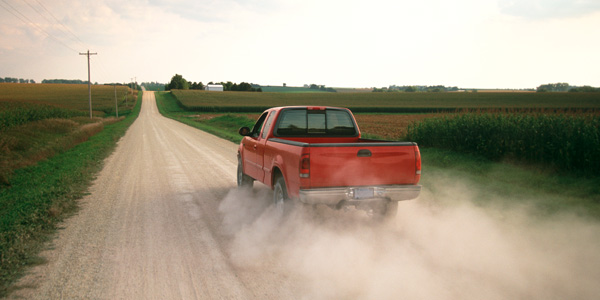
If you have an HVAC system in your house or office, you probably know when the filter media is at capacity, because you start to see dust on furniture. Internal combustion engines operate with some of the same principles: Once the filter is full, it no longer can catch the small particles that pass by, and the engine has to work harder to achieve the same amount of airflow.
For each gallon of fuel, the engine consumes roughly the equivalent of a swimming pool full of air (about 10,000 gallons)! This makes the job of the air filter that much more important. All that air contains dust particles, soot from exhaust fumes and other contaminants.
Environment Matters
The environment in which the vehicle is driven can mean the difference between changing the air filter at the maximum recommended service interval or the minimum. Dusty environments pose challenges for any filtration system, but especially for automotive applications.
The smaller particles between 5 and 20 microns (a human hair is approximately 50 microns) tend to cause the most damage. Dirt can cause the most harm in an engine if it’s ingested into the crankcase. The debris can act like sandpaper on bearings and piston rings once inside the engine.
Fiber Media
Most stock replacement filters are made of a special paper or cellulose fiber material that traps and collects the filtered particles on the top of the filter on the inlet side of the port. Dirt that’s larger than the filter openings is trapped, and the smaller particles pass through. About 93 percent of the dirt and dust is contained in an average pleated-style paper filter. Premium filters in this range can trap as much as 99.9 percent of the dirt and dust.
There’s a big difference in filter-media quality, however, so beware of ones that claim to filter out the most particles, as they might cause too much restriction. There’s a fine line between filtration and allowing the engine to breathe. A premium filter will contain between 98 percent and 99 percent of the dust and still allow the air to flow.
Cotton Filters
Some filters are cleanable and require more maintenance than the throw-away paper filters. Several layers of cotton are impregnated in oil to stop debris from bypassing the filter and entering the engine. Manufacturers of these filters say it’s critical to use the exact amount of oil, because it acts as the primary filtering agent. Not using enough oil will lower the efficiency of the filter, while adding too much oil will increase the airflow restriction and may damage the mass airflow sensor.
Cotton filters are more expensive because they’re reusable and often include new ducting into the intake that keeps the hot air out of the filter for better air density and more power. Whereas a paper filter collects the particles on the top, a cotton filter has a screened layer that catches larger dirt and absorbs smaller particles into the oiled core.
Filter Testing
Air filters aren’t measured in the same micron ratings as liquid filters such as for oil or fuel. Air filters are rated according to ISO 5011 standards that require uniform test procedures, conditions and equipment to perform a comparison of air cleaners. Airflow restrictions, dust-collection efficiency, dust capacity and oil carryover on oil-bath air cleaners are tested to produce the overall capacity rating of a filter.
Intake systems with sharp bends or restrictions are less efficient. It’s like sipping through a kinked straw as opposed to a straight one. Filter construction also is an important factor, in that poorly made elements can come apart (especially in flat-panel designs) and allow unfiltered air to enter. Most automotive filters are tested with fine dust that’s sucked through the filter and weighed until it’s at capacity. Cotton filters have dust-separator screens, so manufacturers will test these with coarser dirt. The bottom line is air filters are only as effective as the environments in which they operate. Changing a filter once a year or more is recommended, but if the filter clogs up to capacity sooner, efficiency drops quickly.







